Uluru Bimble

Beez Neez now Chy Whella
Big Bear and Pepe Millard
Tue 29 Mar 2016 22:17
|
Uluru
Bimble – Mala Walk
 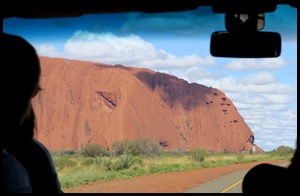 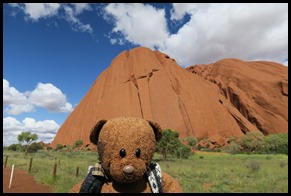 David, our guide, pulled up at the
entrance gate, collected our passes and drove through the National Park - we got
our first up-close look at Uluru. A very excited Beds. The coach stopped to let out those who wanted
to do the ten point six kilometre base walk, the rest of us went to the cultural
centre and then on to do the two kilometre return Mala Walk.
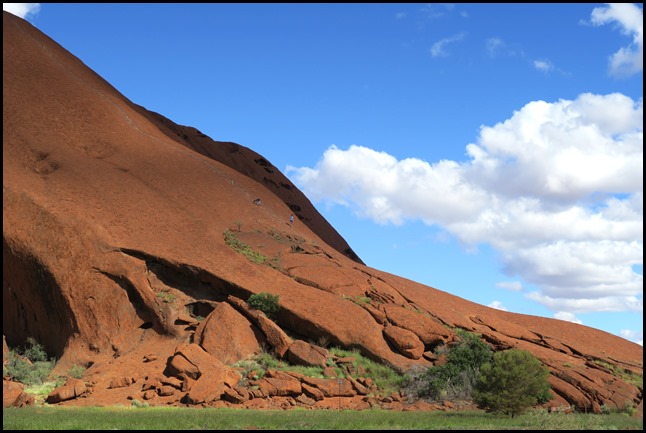 We read a
sign: Warayuki is an Anangu
men’s site and is sacred under Tjukurpa (traditional
law). The rock details and features are equivalent to a sacred
scripture; they describe culturally important information and must be viewed in
their original location. It is inappropriate for images of this site to be
viewed elsewhere.
Particularly
senior men are responsible for these stories which are passed down from
grandfather to grandson. In an oral culture, stories are family inheritance.
Under Tjukurpa, cultural knowledge is earned and with it comes great cultural
responsibility. Please do not photograph or film this
site.
It is also disrespectful to the locals to climb Uluru.
What visitors call ‘the climb’ is of great spiritual significance
to the local Anangu.
The climb is not prohibited, but Anangu
ask as visitors to their land that you respect their wishes, culture and law by
not climbing Uluru.
The path of the climb is associated with important Mala
ceremonies. Anangu believe that during the time when the world was being
formed, the Uluru
climb was the traditional route taken by Mala men when they arrived at
Uluru.
We watched as two ‘climbers’ came down. Numbers of
visitors are monitored, when less than twenty per cent climb in successive years
there will be a case for a total ban. We respected the wishes, plus, it is quite
a steep path and many have died doing it.
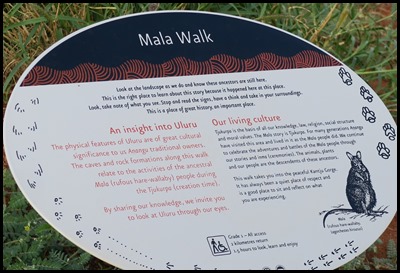  The
information board reads: Look at the landscape as
we do and know these ancestors are still here. This is the right place to learn
about this story because it happened here at this place. Look, take note of what
you see. Stop and read the signs, have a think and take in your surroundings.
This is a place of great history, an important place.
An insight into Uluru.
The physical feature’s of Uluru
are of cultural significance to us Anangu traditional owners. The caves
and rock formations along this walk relate to the activities of the ancestral
Mala (rufous hare-wallaby) people during the Tjukurpa
(creation time). By sharing our knowledge, we invite you to look at
Uluru
through our eyes.
Our living culture:
Tjukurpa is the basis of all our knowledge, law, religion, social
structure and moral values. The Mala story is Tjukurpa. For
many generations Anangu have visited this area and lived in it as the
Mala people did. We continue to celebrate the adventures and battles of the
Mala people through our stories and inma (ceremonies). The
animals, plants and our people are the descendants of these
ancestors.
This walk takes you into the
peaceful Kantju Gorge. It has always
been a quiet place of respect and is a good place to sit and reflect on what you
are experiencing.
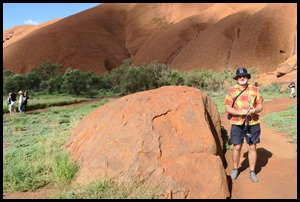  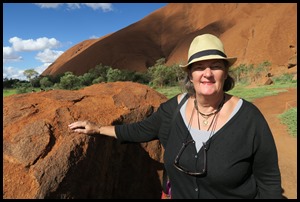 We were just so thrilled to be here
and see up close the unique shapes of ‘the rock’.
 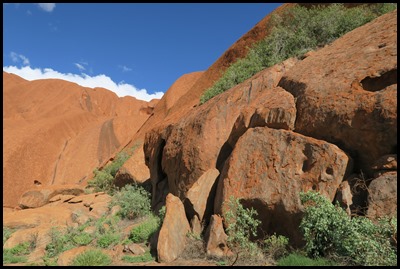 No matter where we looked the shapes changed as did the
colours.
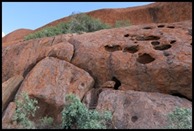 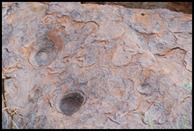 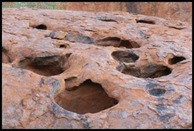 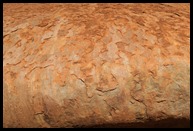 Rock falls,
swirls, layers, reds, simply amazing to
see.
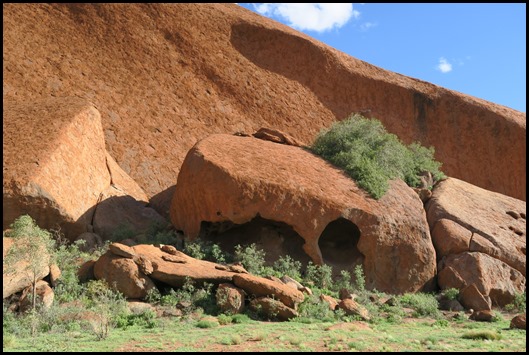 Itjaritjariku
Yuu: In the Tjukurpa (creation time), the ancestral Minyma
Itjaritjari
(marsupial mole woman) built this shelter and yuu (windbreak). The yuu
is the large wedge-shaped stone at the opening to this cave. The holes in the
rocks above the cave have been tunnelled out by the Itjaritjari. Itjaritjari have lived here from the very beginning before Mala
people arrived.
Itjaritjari are
very secretive, spending much of their time underground, occasionally coming out
after rain. They are blind, have soft, golden fur, a backward facing pouch and
are small enough to fit in your hand. Using their front paws like spades, they
tunnel horizontally just under the surface in a swimming motion. A unique
creature that is perfectly adapted to living underground in sandy
deserts.
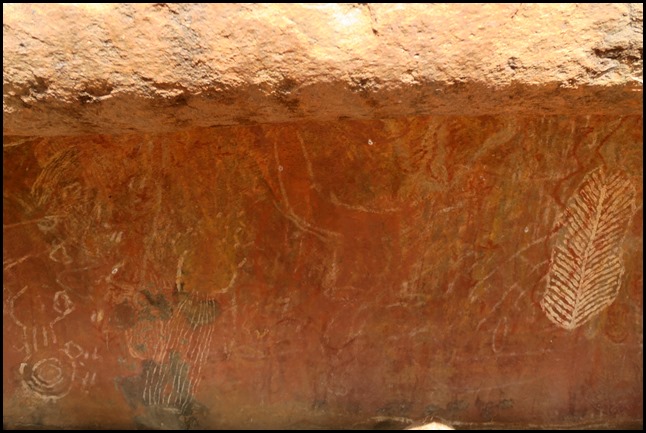 Kulpi Nyiinkaku: Teaching cave: For many generations, Anangu elders taught
nyiinka (bush boys) in this cave how to travel in this country and survive.
Generations of grandfathers painted these pictures, like a teacher uses a school
blackboard, to teach nyiinka how to track and hunt kuka (food animals).
Nyiinka would then be taken into the bush to learn about country – where the
waterholes are, where to find animals, where to source materials for their tools
and weapons.
Cultural heritage: In the very
beginning when the Mala ancestors arrived at Uluru, nyiinka (bush boys)
camped here in this cave. A nyiinka is a boy at the important stage in life
where he is ready to learn to become a wati (man). Nyiinka are taught by their
grandfathers and separated from the rest of their families for this period.
Traditionally this stage could last several years until a boy proved his hunting
skills. When
they weren’t out hunting, nyiinka stayed in this cave. This period has the same
objective as high school: students learn a variety of skills and subjects to
enable them to survive on their own as adults.
Rock painting: The
colours come from a variety of materials. Tutu (red ochre) and untanu
(yellow ochre) are iron-stained clays that were very valuable and traded
across the land. Burnt kurkara (desert oak) provides purka (black
charcoal), and tjunpa/ unu (white ash). The dry materials are
placed on a flat stone, crushed and mixed with kapi (water).
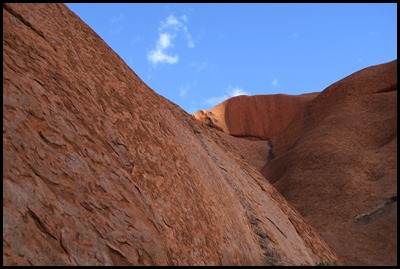  Looking up from the cave – more of an
overhang than a cave, we could see black lines -
these are dormant lichen in old water runs, after it rains the lichen turn green
and active for a short time until once again things dry up.
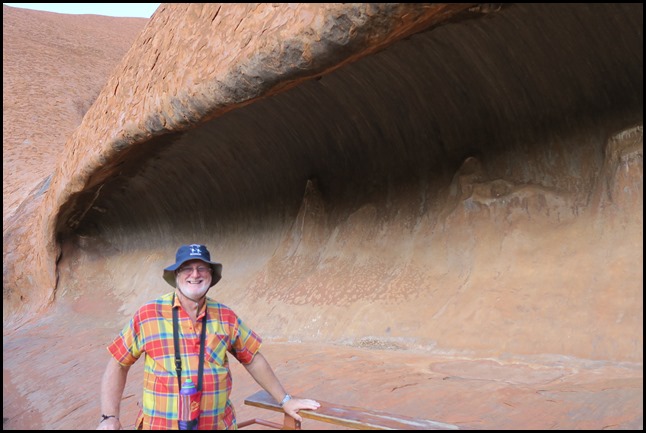 Kulpi Watiku: The Men’s Cave: The Mala people came from the
north and could see Uluru. It looked like a good place
to stay a while and make inma (ceremony). Men raised Ngaltawata
(ceremonial pole) – the inma had begun.
This is the
senior Mala men’s cave. They made their fires here and camped, busily preparing
for inma. They fixed their tools with malu pulka (kangaroo sinew) and
kiti (spinifex resin). From here the men could keep an eye on the
nyiinka (bush boys) in the cave around the corner and watch out for men coming
back from a hunt with food.
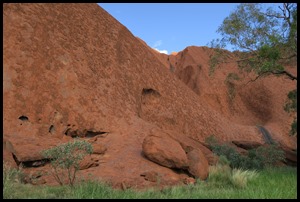 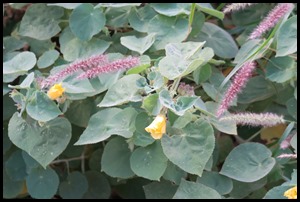 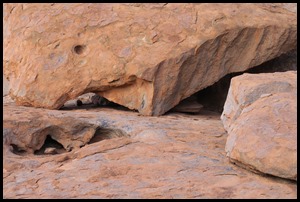 More bimbling and
looking.
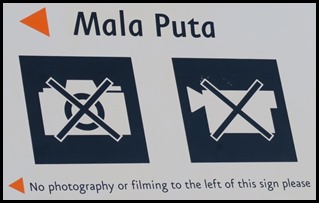  This picture was taken to the right of the exclusion sign. Our eyes could see no difference in the vista from sacred
to ordinary area, but clearly this landscape is known inch by inch to the locals
and they place very special importance to the sacred sites, hence the signs with
arrows – right, left or in one place both sides.
To the left of the picture above
is Malu Puta: This is an Anangu women’s site
and is sacred under Tjukurpa (traditional law). The rock details and
features are equivalent to a sacred scripture; they describe culturally
important information and must be viewed in their original location. It is
inappropriate for images of this site to be viewed elsewhere.
Particular senior women are
responsible for these stories which are passed down from grandmother to
granddaughter. In an oral culture, stories are family inheritance. Under
Tjukurpa, cultural knowledge is earned and with it comes great cultural
responsibility. We were to learn that men’s business and women’s business
are clearly separate, a woman learning of ‘men’s stuff’ could result in death.
It pays not to be too curious in this culture.........
 The Ladies Cave and their story of
events: In the beginning, the Mala people came from the north and
could see this rock. (For the Anangu,
or Aboriginal people, the Mala or 'hare wallaby people'
are important ancestral beings. For tens of thousands of years, the Mala
have watched over them from rocks and caves and walls, guiding them on their
relationships with people, plants and animals, rules for living and caring for
country. Mala Tjukurpa,
the Mala Law, is central to their living culture and celebrated in
story, song, dance and
ceremony).
They thought it looked like a
good place to stay a while and make inma (ceremony). The Mala
men decorated and raised Ngaltawata, the ceremonial pole. The inma had
now begun. The Mala people began to busily prepare for their ceremonies. The
women gathered and prepared food for everyone. They stored nyuma (seed
cakes) in their caves. The men went out hunting. They made fires and fixed their
tools and weapons.
In the middle of preparations,
two Wintalka men approached from the west. They invited the Mala people
to attend their inma. The Mala people said no, explaining
their ceremony had begun and could not be stopped. The disappointed
Wintalka men went back and told their people. Enraged, they created an
evil spirit – a huge devil-dog called Kurpany to destroy the Mala
inma. As Kurpany travelled towards the Mala people he changed
into many forms. He was a mamu, a ghost. Luunpa the kingfisher
woman was the first to spot him. She warned the Mala people but they didn’t
listen.
Kurpany arrived and attacked and
killed some of the men. In great fear and confusion the remaining Mala people
fled down into South Australia with Kurpany chasing them. The story
continues down south. These ancestors
are still here today. Luunpa still keeps watch, but she is
now a large rock. Kurpany’s footprints are imprinted into the
rock heading towards east and south. The men who were killed are still in their
cave.
This story teaches that it is
important to finish what you start and that you should watch for and listen to
warnings of danger.
 Kulpi
Minymaku: The Kitchen Cave: Women, girls and small children
would camp here. The women would go out into the bush to collect mai (bush
foods) and return to the cave to process them. The minymas (women)
would teach the kungkas (girls) this knowledge so they could teach
their children. This knowledge is still passed down today.
Be careful where you stand! Look
closely at the cave floor and you will find smooth areas where seeds were
pounded with round stones. The flour was then mixed with water and the dough
cooked in hot coals to produce nyuma (flat bread). Our ancestors, the
Mala people, brought their food here to share. For generations our
people continued this tradition. Men would bring kuka (meat) and the
women nyuma, fruit and other mai. People would collect their share, delivering
it to their family camps and the old people’s cave. Food would also be sent to
the nyiinka (bush boys) around the corner.
 Tjilpi Pampa
Kulpi: The Old Peoples Cave: This is where the old people sat. You can
see the ceiling is blackened from their fires. During Mala ceremonies
the men who were too old to participate would rest in this cave. They would make
sure the women and children did not enter the men’s ceremonial
areas.
Their spirits are still here,
that’s where they are. They had their spears, weapons and tools with them and
they would cook up malu (kangaroo) and other food their children and
grandchildren would bring them. They would tell stories and teach the children
not to go running off, to stay in camp.
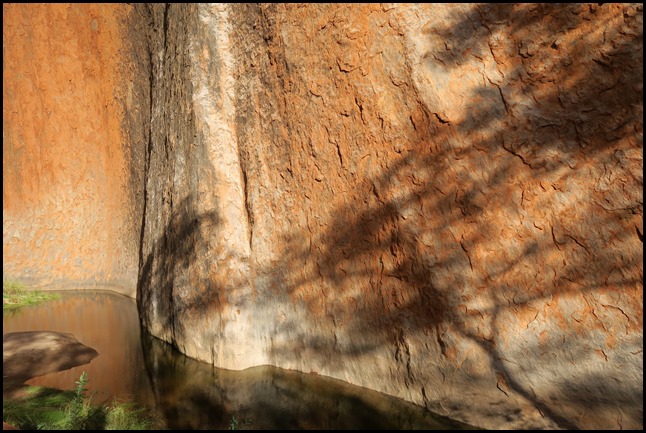 The biggest surprise for us was seeing
a gorge filled with water.
Kantju Gorge: Water is
sacred. Shhh...... This has always been a quiet area of respect. This waterhole
was the main source of water during the Mala ceremonies and for generations and
generations our people and wildlife have depended on it for survival. We always
approached quietly from the side so as not to frighten any animals away.
The Last Emu. We would hide in
the trees and wait for a mob of kalaya (emu) to come and drink. When
they left the waterhole we would spear the last one so the others would not be
frightened of the waterhole in the future, they would just wonder where the emu
went.
Along this walk you have been
learning that every feature of Uluru has significant cultural meaning
to our people. By sharing our stories, we are giving you an insight into how our
knowledge is handed down. This is a quiet place to sit and think about what you
are experiencing.
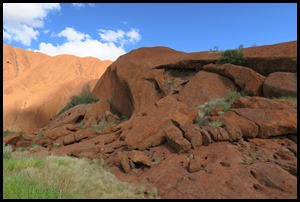 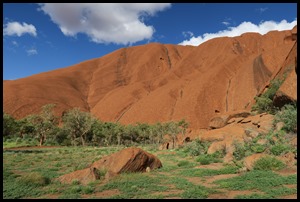 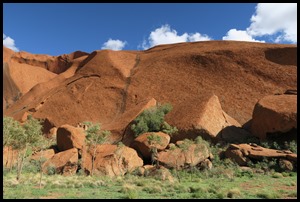  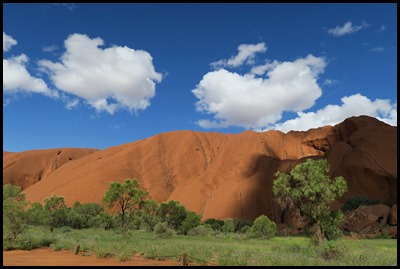 ALL IN ALL WONDERFUL TO BE UP
CLOSE AND PERSONAL
REALLY
INTERESTING SPECIAL TO BE HERE
|